More results...


Polymers with saturated bonds are more stable than unsaturated polymers because unsaturated bonds are easily attacked by O2.
Linear polymers are more stable than branched polymers. Because linear polymers tend to crystallize. In crystalline polymers, polymer molecules are packed well. So, O2 molecules cannot easily enter the polymer structure. That means the degradation is low.
But in branched polymers, there are branches that are connected to the backbone. Due to these branches, the polymer tends to form an amorphous structure. Oxygen can easily enter into An amorphous structure. Therefore, the degradation of the amorphous polymer is fast. Crystalline polymers are more stable than branched polymers.
Polymers that have electron-withdrawing groups such as -CN, Carbonyl, Peroxy, and -OR have low stability. Because such groups lower the bond energy of adjacent C-H bonds. It causes the degradation of the polymer.
| Bond | Branch dissociation energy (KJ mol-1) |
| CH3-H | 104 |
| C2H-H | 98 |
| (CH3)2CH-H | 44.5 |
| (CH3)3C-H | 91 |
| CH2=CH-H | 104 |
| CH2=CH-CH2-H | 85 |
| C6H5-H | 104 |
| H3[COCH2-H] | 92 |
| CH3CH(OH)-H | 90 |
The stability of a polymer against degradation can be increased in two ways. Stability can increase either by adding stabilizers or modifying the polymer structure.
Polymer structure can be modified chemically by adding or removing functional groups. Polymers with unsaturated bonds and branches have low stability. Removing unsaturation and reducing branching can increase stability.
Functional groups such as -CN, -OR, carbonyl, and peroxy, reduce the stability of the polymer. By removing their stability can be increased. When the polymer backbone is directly connected to an aromatic group as a pendant group, it increases the reactivity of adjacent Hydrogen. That means it decreases stability. But when aromatic groups are in the backbone of the polymer, that causes to increase in the stability.
But when aromatic groups are connected indirectly to the backbone it increases the stability. Because of the protection of the bulky group, the polymer cannot be attacked by another group. That is called the “Shielding effect”. Completely aromatic polymers such as 'polyparaphenylene' are very thermal stable. If the polymer has fused ring structures on the backbone of the polymer has high thermal stability.
Atoms such as O, S, and N increase the reactivity of the adjacent hydrogen atom. So, these atoms are removed.
If H is replaced by an F (Fluorine) atom, it increases thermal stability. That is why PVC is more stable than polyolefin. Neoprene which has a Cl atom in its repeating unit is more stable than natural rubber.
Ladder polymers have high thermal-oxidative stability. Although a bond breaks, it can heal easily. Because the polymer chains are very closer to each other.
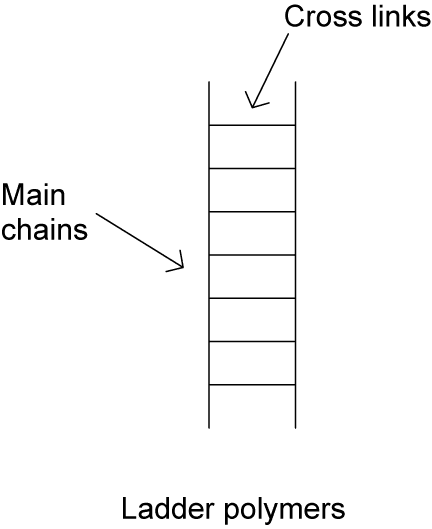
Parallel polymer chains are connected at frequent and regular intervals by short chains to form a crosslinked ladder structure. They show unusual resistance to degradation even though the structure shows normal reactivity toward oxygen. These crosslinks prevent cleavage into segments.

Oregano silicon polymers are polymers that have silicon in the backbone. They have high thermal-oxidative stability.
This polymer has unusual stability due to the thermal oxidative stability of the ligan combined with the inorganic backbone structure. Each silicon atom in polysiloxane is surrounded by a bulky planner ligan. These have high thermal-oxidative stability. Removing reactive sites and replacing alkyl groups with phenyl groups increase thermal stability.
However, few modified polymers are applicable. They, themselves have a lot of other drawbacks. The main drawback is the modification is a costly method. It increases the cost of the final product also. Due to their lower solubility and high softening temperature processing is very difficult.
And, chemical modifications can alter the essential properties of the material (polymer loses its original property.) So, adding stabilizers is the most feasible way to increase the stability of polymers.
Stabilizers which are also known as Antioxidants are added to the polymer to prevent degradation. Generally, there are two types of antioxidants based on their chemical structure.
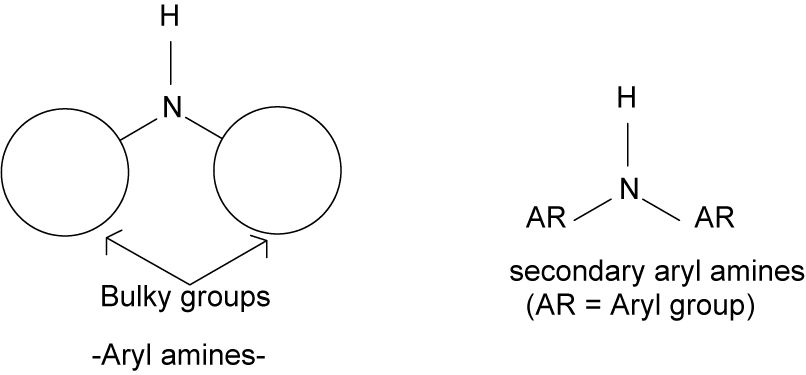
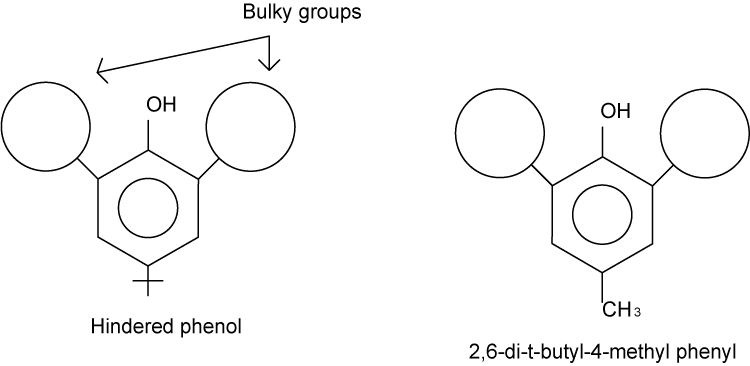
Several factors should be considered when selecting a stabilizer.
A stabilizer can be a short-term stabilizer or a long-term stabilizer.
When polymer synthesis, processing, and fabrication, a polymer is subjected to high temperatures. So, polymers are susceptible to thermal-oxidative degradation at these stages. Therefore, stabilizers need to be added to protect the material at these stages. so, short-term stabilizers are used to protect the polymer in polymer synthesis and fabrication.
Additional stabilizers are required for the storage and application stages. These stabilizers can add during the fabrication step.
Different classes of antioxidants are available according to the mechanism which increases the stability.
“Antioxidants which absorb radiations, heat, and reject metal catalysts and decrease forming ROOH are called preventive antioxidants”
Preventive antioxidants inhibit or retard the formation of free radicals in the initiation step (retard the oxidation process) They interrupt the chain process by interrupting alkyl radicals (R*) or peroxy radicals (RO*). This type of antioxidant actually slows down oxidation without changing the mechanism.
There are two categories of preventive antioxidants
Metal ions in the polymer can form unstable condition complexes with hydroperoxide followed by electron transfer reactions which will produce peroxy radicals. Two reactions have occurred when degrading a polymer that has metal ions.

Reaction 1 follows by strong reducing agents and reaction 2 follows by oxidizing agents. Degradation can reduce by preventing these reactions. Metal ion deactivators prevent the above two reactions by strongly complexing the metal ion to its maximum coordination number or by stabilizing its valance site or by precipitation of metal ion.
These types of preventive antioxidants prevent degradation by converting hydroperoxides into stable inert products.
Chain-breaking antioxidants interrupt the propagating cycle by reacting with free radicals (R* or RO*). This reaction can be an addition, coupling, hydrogen transfer, or electron transfer reaction. This type of antioxidant introduces a new termination reaction. Then the machine will be more complex. This mechanism is called retarded antioxidant mechanism.
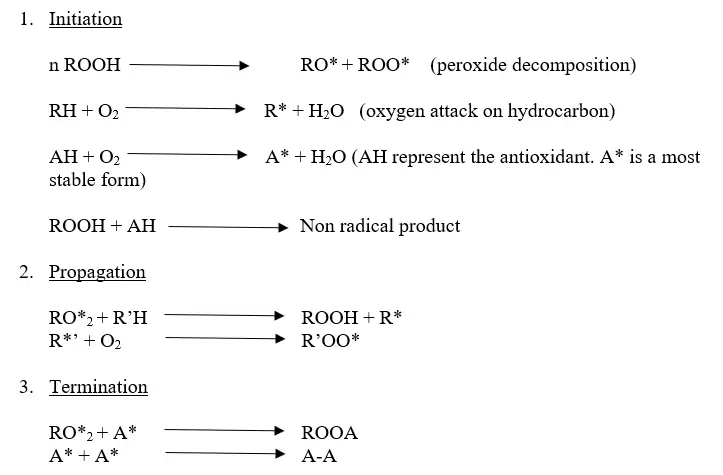
After the optimum level, antioxidants help to decompose. That is called the “Pro oxidation effect”
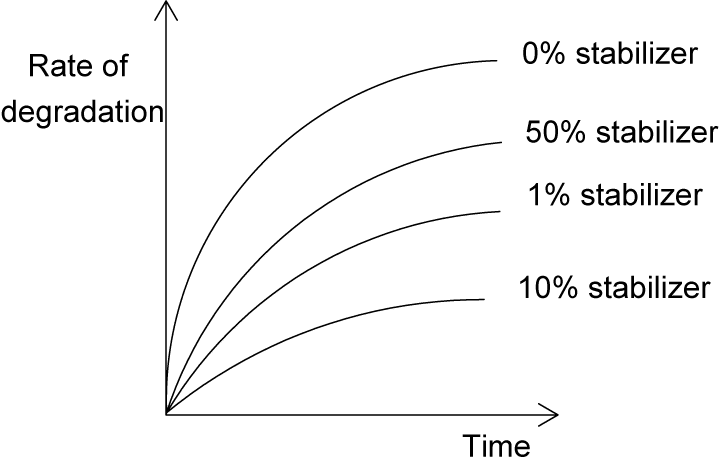
By mode of action, chain-breaking antioxidants can be divided into three categories.
Free radical traps are substances that have the capability to react with free radicals and form stable radicals. These radicals do not re-initiate the degradation. Later, these radicals can undergo dimerization, disproportionation, or reaction with a second alkyl radical to form a stable product.
Carbon black is an effective inhibitor. Its structure is an agglomerate of complex condensed polycyclic aromatic rings with hydrogen and reactive functional groups around the edges. They can trap free radicals by additional mechanisms and convert them into stable radicals while terminating their kinetic chain.
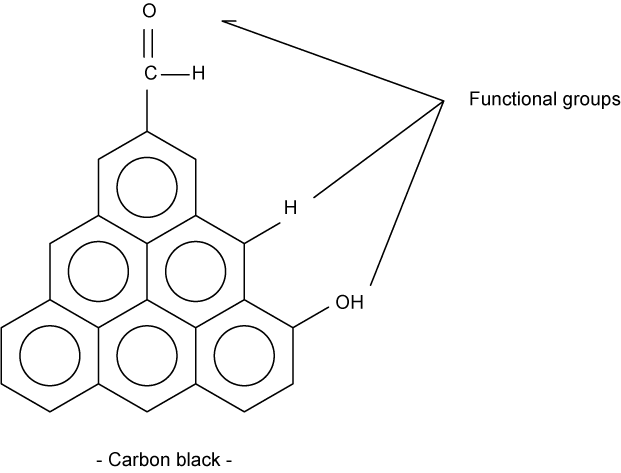
Alkyl nitroxides, aryl nitroxides, and pyridine-type nitroxides are used. alkyl nitroxides are less practical compared to aryl nitroxides. Aryl nitroxides are the most stable and better antioxidants that can react with both alkyl (R*) and peroxy (ROO*) radicals.
When radicals are present hydrogen can react with radicals and form stable radicals.
This type of antioxidant donates an electron to the radicals and forms a salt.
Example: - tertiary amines

Hydrogen donors are very common antioxidants in the industry for thermal oxidation.
Examples: - hindered phenols and secondary arylamines.
Phenols and arylamines have reactive hydrogen. This hydrogen will be donated to the free radicals and form stable radicals. These stable radicals are also used as trap radicals.
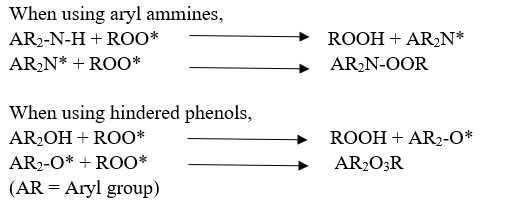
There are many different types of stabilizers available today that may function in different ways. As an example, if a stabilizer is selected to inhibit the initiation process, or to interrupt the propagation step, combining them may be beneficial in many instances.
When stabilizers mix with each other, they will retain their character. So, the combined effect is additive.
Example: -

Antagonistic stabilizers show a lower total effect than the sum of the individual effect.
Examples: - Carbon black + secondary aryl ammine
Carbon black + alkylated phenol
Secondary aryl amines or alkylated phenols with carbon show antagonistic effects. Carbon black has holes and functional groups on the surface. So, it can absorb other stabilizers. This makes less availability of stabilizers.
Synergistic stabilizers show a greater total effect than the sum of the individual effect. There are two types of synergism as “Homo-synergism” and “Hetero-synergism”. Homo-synergism involves two stabilizers of unequal activity operated by the same mechanism. Hetero-synergism generates by the cooperating effect of two or more antioxidants acting by different mechanisms. Hetero-synergism can be observed when mixing chain-breaking antioxidants and preventing antioxidants.
There are some antioxidants that have two or more kinds of antioxidant activity associated with the same molecules. It is called “Auto-synergism”
Examples: -
Read more about polymer degradation and stability here.

Cover Image Attribute
1. Image by Various-Photography from Pixabay
2.Image by William Iven from Pixabay
3.Image by Yao Charlen from Pixabay
4. Image by ClassicallyPrinted from Pixabay
5. Image by James Wheeler from Pixabay